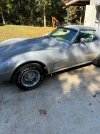I have this 1975 corvette. It’s still got the original silver metallic acrylic Lacquer paint that it left the factory with. The paint is very faded with no shine but still very solid with no flaking or crazing just some small chips.((except for the t tops). I tried wet sanding and buffing a small place on the hood. It’s shiny in that spot but looks very blotchy now. So my plans are to repaint it over the winter. My question to the forum is would it be ok to epoxy prime over the existing acrylic lacquer or does it have to be stripped to bare fiberglass? Thanks
Mike
Mike

